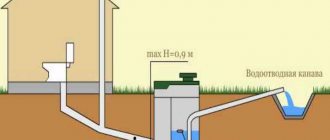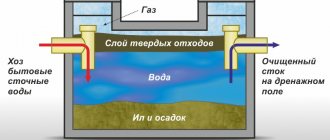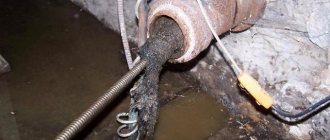When the sewage system works properly, it is taken for granted and unnoticed by others. In order for this to happen, it must be properly designed and laid out correctly. Errors when laying sewers can result in a certain section of the pipeline freezing in winter. Of course, this won’t happen in the summer, but in the winter such an annoying mistake will become obvious and cause a lot of trouble. Proper installation takes into account the depth of the sewer pipe and the material for its manufacture. Plastic pipes differ from cast iron pipes in terms of thermal conductivity. The freezing of the sewer system is influenced by the diameter of the pipe, the angle of its laying, and other factors.
Causes of freezing sewer pipes
Reasons that can cause sewerage to freeze:
- The angle of inclination of the pipes is incorrectly selected. Wastewater stagnates in one place, freezes and forms an ice plug;
- shallow trench depth. According to SNiP standards, it should be below the level of soil freezing in winter, but in practice this is not always observed;
- lack of heat insulation on the pipes themselves and at the points of exit from the walls of the house or the entrance to the septic tank;
- excessively small pipe diameter, less than 110 mm;
- the occurrence of condensation, which freezes when the temperature drops;
- blockages that have arisen. The settling of organic matter on the walls of the pipes gradually blocks the cross-section, allowing the drains to freeze during the cold season.
The water in the septic tank freezes for two reasons:
- poorly organized overflow into an adjacent container;
- the distance to the septic tank is too large, which contributes to the cooling of the wastewater along the route.
In any case, when a sewer pipe in a private house freezes, there are one or more similar reasons.
Hot water helps
Defrosting with hot water
If you determine that the frozen area is small, we recommend the simplest method. Even a child can do this. It is enough just to fill the sewage system with hot water with added salt. Cheap and cheerful. As water flows to the site where the plug is formed, it will gradually defrost it. This method is good for its simplicity and effectiveness.
In the case where the plug is located far from the sewer outlet, this method will be useless. By the time the water reaches the place of formation, it will simply cool down. Therefore, it is recommended to use hot water only when the plug is close and small.
This method is universal and suitable for both plastic and metal sewer pipes.
Pros:
- simplicity;
- efficiency;
- no additional tools required;
- everything you need is at hand;
- versatility.
Minuses:
- only valid under certain circumstances.
How to defrost the system?
So, the sewage system in a private house froze underground. There are two main defrosting methods:
- chemical;
- thermal.
The use of chemical compounds is rare. This is expensive, and the effectiveness of the technique is extremely low. The only advantage is that you don’t have to dig up pipes. Materials are introduced into the internal cavity from inspection hatches or manifolds, and are supplied from inside the house through the drain of plumbing fixtures. However, before you warm up a frozen sewer using special means, you should know their composition and capabilities. Otherwise, there is a threat to active bacteria living in the septic tank. Most compounds are aggressive and help destroy bacteria that process organic matter. Practice has shown that the use of these materials does not give the desired effect.
Thermal methods are simpler and more reliable. The only drawback is the need to ensure direct contact of the hot medium with the ice plug. If the sewer is frozen, there are several ways to warm it up. There are simple and complex techniques that can solve the problem in different situations. Let's first consider more accessible options:
Flushing pipelines with hot water
This is one of the simplest answers to the question: a sewer pipe underground is frozen, what should I do? Use hot water with added salt. The method is most successful if a vertical section of the system is clogged - a riser or an elbow at the exit from the foundation. Advantages of this method:
- accessibility and simplicity;
- relatively high speed of problem resolution.
The effectiveness of flushing with hot water is high if it is necessary to clean an area located close to where the system exits to the outside. For remote traffic jams, this method may not be suitable, since the water cools down along the route and loses its energy.
as an option!
You may also like:
Connecting the bathtub to the sewer - procedure + video review!
Sewer aerator - what is it for, types and how it works!
Use of a blowtorch
Using a blowtorch allows you to quickly and efficiently break through an ice plug. However, the technique requires compliance with certain conditions:
- it is necessary to know exactly where the blockage is occurring;
- sewer pipes must be cast iron (or other metal);
- you will have to dig a trench to gain access to the surface of the pipelines.
The process itself is not difficult at all, but excavating frozen soil in winter is not always possible. In addition, freeing a section of pipe may only increase the blockage. Therefore, a blowtorch is usually used only for local areas that are in direct access - the pipe exit from the wall, the entrance to the septic tank.
Using hot steam
A situation that often occurs is that a sewer pipe is frozen, what should you do if it is plastic? There is a gentle heating method that gives quite positive results. This is blowing out the pipe cavity with hot steam. To perform the procedure, you will need a steam generator that supplies steam to a tube (usually a rubber hose). It is pulled inside the pipeline until the end hits the ice plug. After this, steam is supplied and the clog is warmed up, gradually moving the hose as it melts. If the plug is large, the melt water will need to be pumped out. Otherwise, the effectiveness of the procedure will drop sharply - thermal energy will be taken away by the water. The method is effective, but to implement it you will need to purchase special equipment.
What to do if the sewer in your house is frozen
Having understood the reasons for its occurrence, it will be much easier to solve the problem and prevent it from occurring again. If pipes freeze, there are three ways to defrost them.
Internal heating with boiling water
The first thing that comes to mind when you discover frozen areas is to open the hot water tap and fill the drain with it. This is ineffective and will only help with minor freezing.
In other situations it will only get worse:
- Firstly, warm water will be evenly distributed throughout the pipeline and will not be able to warm up the ice plug.
- Secondly, the pipes will quickly fill up and sewage may come to the top.
Advice! You cannot pour boiling water onto the pipe - heating should be gradual and uniform.
The water in the sewer underneath the bathhouse froze
Correct solution:
- Determine the location of the ice plug. The most problematic areas are pipe turns, their joints and long horizontal sections without insulation.
- Open the revision closest to the found point.
Interesting to know! If sewerage installation standards are met, inspection hatches should be located every 10 m on level areas.
- The cable for cleaning sewer passages is tied with adhesive tape to a long thin hose. There is no need to make a spiral connection to destroy blockages - the required indentation is 3-5 centimeters. The hose can be additionally fixed every 50-80 cm.
Cable for cleaning sewer pipes
- The hose with the cable is immersed in the lumen of the pipe and pushed forward until there is an “ice blockage”. Now you can supply coolant directly to the problem area. Before doing this, you should try to break through the plug with a cable, sometimes this is enough.
- If that doesn’t work, put a funnel on the other end of the hose and attach it to something so you don’t have to hold it with your hands while pouring hot water.
- Boil 5-6 liters of water, let it cool to +70-80 degrees and pour 5 tablespoons of salt into it - the steeper the salt solution, the better.
- Once the salt has dissolved, pour it into the hose. This temperature will not damage the pipes, and it is more than enough for heating ice. If there is already water in the pipe, there will be no normal flow of saline solution. It must be pumped into the hose using a large medical bulb (enema).
Flushing the pipe with boiling water is the right remedy
- After pouring, wait a few minutes and try to push the ice with a cable. If nothing works, repeat the procedure. Excess water will exit through the inspection hatch.
As soon as it becomes clear that the ice has broken, it is necessary to close the inspection and open the hot water taps in the house until the normal flow of liquid in the sewer completely stops.
This method can defrost up to 1 meter of pipe in an hour.
External heating
It is much easier to act when the frozen section of the pipe is openly accessible - no inspection or cable is needed. You will need a thick absorbent cloth and hot water.
Heating the pipe with boiling water
Heating the pipe with boiling water:
- Wrap the frozen area with a rag. It will hold warm water near the pipe. If the pipe is plastic, it will not warm up quickly, since this material has low thermal conductivity.
- Boil water, cool slightly.
- Pour water, distributing it over a rag. The main part will flow onto the floor, so heat up a lot of water.
- Place a container underneath to catch the water. It will still be hot for some time, so you can scoop it several times.
The rag will work as a heat condenser. The method is effective, but it may not always be useful.
Other devices can be used for external heating. For example, if the pipe is cast iron, it can be heated with a gas burner. This will take no more than a couple of minutes.
If the pipe is made of plastic, you can use a powerful hair dryer instead of a blowtorch. It heats well, so do not bring it close to avoid damaging the pipe.
Warming up the sewer pipe with a hairdryer - there is always a way out
An effective and safe method is steam heating. To do this, place a container of water under the heated section of the pipe and lower the boiler into it. The steam will heat the pipe very quickly .
Internal heating of the pipe
This method also requires access to the sewer lumen, although if the pipeline is not too tortuous, you can try to reach the plug with a flexible wire.
Complicated defrosting conditions
To effectively warm up large plugs, electric heating devices, for example, an old heating element or an army boiler, are suitable.
Application of heating element
The heating element must be of such a size that it can pass normally through the frozen pipe. The devices are attached to the same sewer cleaning cable and moved to the site of the blockage.
All electrical connections must be carefully sealed with electrical tape to prevent water from entering them.
The sewage system in the house is frozen, what to do - a homemade device made from heating elements to heat the pipe
The devices are connected to the network until the plug is completely thawed. The main thing is not to miss the moment of draining the water. At the moment of heating, there must be liquid in the pipe, otherwise there will be nothing to heat up.
The use of a heating element and a boiler is complicated by the fact that they should not touch the walls of the pipe, as it can melt. Therefore, a small wire casing is constructed that does not allow contact.
A homemade army boiler can be used in a similar way. It is made from two blades mounted on matches on both sides, as shown in the photo.
People's army boiler - such a device will also need an external casing
There is another original way
The old extension cord is hooked to the cable and pushed towards the ice plug. Once in the water, it will not short-circuit. It is enough to plug it into the network, and it will work on the same principle as an army boiler - the water will begin to heat up quickly.
The plastic housing will prevent the terminals from touching the pipe walls.
Using terminals from a welding machine
The most drastic method is used if the pipe is metal. Since it conducts electricity, you can build a huge heater out of it.
Connecting a metal pipe to a transformer
Clamps from the welding machine are thrown onto the ends of the pipe. The circuit is grounded and then turned on. This can be done by a professional electrician, otherwise the consequences can be very serious.
Warming pipes with alcohol is not relevant, as it is expensive and not as effective.
Other ways to solve the problem
There are alternative ways to defrost sewers. If a sewer pipe is frozen, the following methods can be used:
- For cast iron parts of the system, electric defrosting is used. Contacts are attached to different ends of the problem area and voltage is applied to them. The metal heats up, the layer of ice melts and clears the passage for drains;
- the surface of the pipes is wrapped with a special heating cable, which transfers its heat to the internal blockage;
- heat the plug with hot air. To do this, use a compressor or heat gun. The method requires the availability of appropriate equipment.
The most effective methods include hydrodynamic cleaning. The procedure requires special equipment, but a regular Karcher-type car wash will do. If the sewerage system in a private house is frozen, how can you warm it up using the hydrodynamic method? The process is simple - a hose with a special nozzle is inserted into the pipe to a depth of about 1 meter, after which water is supplied. High pressure and a specific location of the outlets allow you to break up stubborn blockages and push the hose forward. The procedure is quick and has virtually no unsuccessful results. It is recommended for all owners of an autonomous sewer system to do this cleaning - the system will always be in order and remain operational for a long time.
Steam vs ice
Steam generator
If your pipes are made of plastic, it is problematic to use an open fire. But this is not a problem, since steam generators are provided for this purpose, which will help you restore the system with hot steam. You just have to go to a specialized store and purchase this unit.
If you don't want to spend money, you can ask your neighbors or friends if they have a steam generator. They may lend it to you for work.
How is the work done?
- The steam generator is filled with water.
- A hose is inserted into the sewer pipe, at the end of which there is a nozzle. It needs to be pushed all the way into the ice plug.
- The device starts up.
- As the plug melts, you need to move the hose further until the plug is completely removed.
The peculiarity of using a steam generator is that if you need to defrost pipes located underground, you don’t have to dig anything.
Pros:
- safety;
- efficiency;
- simplicity.
Minuses:
- purchase of expensive equipment.
Hydrodynamic washing with defrosting
One of the varieties of this method is hydrodynamic flushing. For this purpose, installations are used that supply hot water under pressure. Thanks to this, you will not only remove the blockage, but also get rid of blockages in the pipes. Also, thanks to this method, you can check if there are damaged pipes in the system.
Prevention
Instead of deciding how to heat the sewer, it is better to exclude the possibility of such situations in advance. In order to eliminate the possibility of the system freezing, it is necessary to comply with all SNiP requirements at the construction stage. Turns or bends should be avoided and all lines should be kept as straight as possible. In addition, it is important to ensure the correct angle of inclination of the sewer. The rules for creating a system are set out in detail, the main thing is to be careful and take your time.
How to detect where ice jams form:
Before you start heating the sewer, you need to determine the place where the ice plug has formed. This is done as follows:
- The plumbing cable is inserted through the inspection window on the side of the house. If there is no such window, you will have to disconnect one of the plumbing fixtures: toilet, sink or washing machine.
- Then the same measurements are taken from the side of the septic tank or cesspool: this will help determine the approximate size of the plug.
How to defrost sewer and septic tank. 7 proven methods
While it's warm outside, you don't have to think about sewage problems. But winter is not the time to relax. And if it’s suddenly colder, and you notice that the water doesn’t drain well from the sink or toilet, it means that the pipes or septic tank are most likely frozen. We have collected 7 simple but really working methods that will help solve the problem of a frozen sewer system.
Ice in pipes is very bad for the sewer system!
Properly installed communications should work stably even at negative air temperatures. And if they fail during severe frosts, it means that there were violations during installation.
How to defrost a frozen sewer pipe - methods and means
The work of the sewerage system is invisible as long as everything goes as expected. The design and installation of a sewer system is accompanied by taking into account many factors, including operation in conditions of low temperatures. However, a situation cannot be ruled out when the sewer freezes in the ground (a certain section of the pipe freezes). Under normal conditions this should not happen, but installation errors may appear in winter.
By the way, when trying to understand at what temperature the sewage system freezes, you should take into account not only the location of the pipes, but also the material from which they are made (the thermal conductivity of plastic and cast iron is very different), the diameter of the pipe, the slope angle, i.e. the action of many factors in combination.
External heating methods
In addition to using a blowtorch, there are other ways to heat pipes externally. For example, to solve the problem of how to thaw a frozen sewer if the pipes are metal, the electric defrosting method is often used.
To do this, terminals are fixed along the edges of the emergency area, voltage is applied to them, the metal heats up and the ice plug inside melts. In addition, defrosting the sewer using external heating can be done using:
- Hot air produced by a heat gun.
- Self-heating cables that are placed on pipes.
Why do pipes freeze?
The main reason for freezing of sewage drains is errors made at the system assembly stage. These include:
- the depth of the trench does not reach the level of soil freezing;
- lack or low quality of insulation;
- the slope of the pipelines is too small or large.
Often there are several reasons for freezing of the system at the same time. Before you defrost a sewer pipe, you need to find out what allowed the drains to freeze. Let's take a closer look at the possible reasons:
Small pipe immersion depth
According to the rules, sewer pipes must be installed at a depth exceeding the freezing level of the soil during the cold season. This rule is often violated, since in some regions the depth exceeds 2 meters. They build the sewerage themselves; digging trenches to such a depth is too difficult. Sometimes groundwater interferes, which lies close to the surface and does not allow the correct depth to be obtained. In such cases, it is necessary to take measures to protect the pipes from exposure to low temperatures. It is recommended to install effective insulation. Some owners install a heating cable attached to the surface of the pipe.
Lack of insulation
Since it is very difficult to defrost a sewer pipe underground, it is necessary to take preventive measures to insulate the system. However, many owners approach this issue too carelessly. They believe that the drains are warm enough and pass through the pipes quickly, so installing a thick layer of insulation is impractical. This is an erroneous point of view, leading to the rapid formation of blockages. Insulation and drainage are important elements that ensure the system operates during the cold period. They cannot be neglected, especially in regions with frosty winters and complex groundwater dynamics.
Incorrect pipe slope
There are certain standards that determine the amount of slope for pipelines of different diameters. These values give the minimum and maximum angle values that ensure the correct flow of liquids. The standards for the slope of the system have been developed over many years of practice, and they should not be violated. Otherwise, you will have to decide how to defrost the sewer pipe.
If pipes are laid too shallowly, areas with stagnant wastewater will form. Sooner or later they will freeze and form an ice plug. Excessively steep styling is also harmful. With it, liquids pass too quickly into the receiving container, and solid particles remain in the pipes and create complex blockages.
You may also like:
The sewer is frozen, what to do and how to warm the pipe?
Sewerage in a wooden house: how is it arranged and how to do it yourself?










